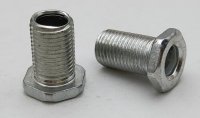一、m4板牙外径多大?
M4有粗牙,细牙之分
1.粗牙M4的,螺距P=0.7,粗牙记法:M4;
2.细牙M4的,螺距P=0.5,细牙记法:M4x0.5。
据所知m4螺纹尺寸是公称直径为4mm,螺距为0.5mm。螺距,螺纹上相邻两牙对应点之间的轴向距离。希望能够帮到你!
二、螺丝钉M4有多大?
螺丝钉M4直径是3.4。
M4的螺距为0.7,钻孔直径为3.4(但实际中一般也钻3.2的孔径,主要看攻丝时方不方便),一般用麻花钻(麻花钻是从实体材料上加工出孔的刀具,又是孔加工刀具中应用最广的刀具)。
三、m4杯头螺丝的外径是多大?
M4杯头螺丝的外径为7.5mm,长度最短为8mm,最长为50mm。
1、螺栓:机械零件,配用螺母的圆柱形带螺纹的紧固件。由头部和螺杆(带有外螺纹的圆柱体)两部分组成的一类紧固件,需与螺母配合,用于紧固连接两个带有通孔的零件。
谢谢大家,希望能帮到你们!
四、m4螺纹外径?
外径是4mm(毫米)。m4的螺栓其公称直径也是螺纹外径4毫米。如果螺栓不加特殊标注,被称为标准螺栓,也叫普通粗牙,如果标上m12x1,就是12直径螺栓为细牙螺纹。螺栓与螺帽或工件底孔配有很严格要求,一般按公称直径减去牙距为底孔应钻尺寸,而后攻丝。机械行业的工件之间配合有多种,紧配合,压配合,松配合或过渡配合等,大体尺寸一样,配合程度根椐需要利用公差来调整之间关係。
比如三轮车,自行车中轴与拐子间配合需紧配合,需用榔头砸入,否则骑行易松脱。
五、m4螺帽套筒外径?
m4螺母就是螺母规格是4mm。
m4螺丝要配多大的螺母
螺栓是标准件,公制螺栓有一系列的的规定,其代号为M,如M5、M4 ---等,在使用中不管是螺栓、螺钉、螺母、平垫圈、弹垫圈---,只要是同一规格的就能通用,例如:你说的4MM估计是指的M4螺栓,那么所需的所有配件,指明M4所用就可以了,配件的大小、厚度、制造质量、等都有按照相应的国标规定来制造的产品。
六、m4螺栓外径尺寸?
螺栓外径尺寸,也就是螺栓的大径,即公称直径,代表着螺栓的直径。在这里,m4中的4就是螺栓的外径尺寸,即4mm。
七、m4螺杆外径标准?
m4螺丝直径为3.4毫米。
1、基本的螺纹规格标准有M3、M4、M5螺钉。不锈钢m4螺丝安装时遇到的问题变少,不需要去害怕传统锚栓钻孔的时候会倾斜,通过对不锈钢螺丝抗腐蚀性与断裂原因分析,在安装不锈钢螺丝的时候可以直接打洞,然后再安装,这样成功率能够达到将近百分百。
2、螺钉的牙形有细牙粗牙、左旋右旋。扳拧方式是指安装和紧固螺钉时扭转螺钉头部的方式,基本方式有外扳拧和内扳拧两种。一般来讲,外扳拧比任何形式的内扳拧(内凹槽)允许的扭矩要更大一些。外扳拧:六角、六角法兰面、六角凸缘、六角花形等;内扳拧:一字槽、十字槽H型、十字槽Z型、十字槽F型、四方槽、复合槽等。
八、直埋保温管外径多大
直埋保温管外径多大
直埋保温管是一种应用广泛的管道系统,用于保护输送介质免受外界环境的影响。直埋保温管外径的大小通常是根据特定项目的要求来确定的。不同的项目可能有不同的需求,因此尺寸选择至关重要。那么,在选择直埋保温管外径时有哪些因素需要考虑呢?
1. 介质输送量
直埋保温管的外径大小直接关系到介质的输送量。如果输送量较大,一般会选择较大的外径来确保管道的稳定性和安全性。相反,如果输送量较小,较小的外径可以更好地满足需求。
2. 环境温度
环境温度对直埋保温管外径的选择也有一定的影响。较低的环境温度可能需要选择较大的外径来提供更好的保温性能,以防止介质在输送过程中的温度损失。
3. 管道长度
管道的长度也是考虑直埋保温管外径的重要因素之一。较长的管道通常需要更大的外径来减小热损失,并确保介质在输送过程中保持适当的温度。
4. 预留修复空间
直埋保温管系统是经过精心设计和安装的,但在使用过程中难免会出现一些问题,需要进行维修和更换。因此,在选择直埋保温管外径时,还应考虑预留足够的修复空间,以便能够更轻松地进行维修工作。
5. 管道材料
直埋保温管外径的选择还与管道材料有关。不同的材料具有不同的热传导性能和密度,因此需要根据具体情况选择合适的外径尺寸。
总结:
直埋保温管外径的大小对管道系统的效果有着重要的影响。通过合理选择外径尺寸,可以实现更好的保温效果,提高介质输送的效率和安全性。因此,在选择直埋保温管外径时,需要综合考虑介质输送量、环境温度、管道长度、预留修复空间以及管道材料等多个因素,并根据具体情况作出合适的选择。
In this blog post, we will discuss the importance of determining the outer diameter of direct buried insulation pipes, commonly known as "直埋保温管外径多大" in Chinese. These direct buried insulation pipes are extensively used in various piping systems to protect the conveyed media from external environmental conditions. Determining the appropriate outer diameter of these pipes is crucial as it directly impacts the efficiency, stability, and overall safety of the pipeline system. 1. Conveyed Media Flow Rate The outer diameter of direct buried insulation pipes is closely related to the flow rate of the conveyed media. For high flow rates, it is generally advisable to select a larger outer diameter to ensure the stability and safety of the pipeline. Conversely, for lower flow rates, a smaller outer diameter may be more suitable to meet the requirements adequately. 2. Environmental Temperature The selection of the outer diameter of direct buried insulation pipes is also influenced by the ambient temperature. Lower ambient temperatures may require a larger outer diameter to provide better insulation performance, preventing temperature loss during the media transportation process. 3. Length of the Pipeline The length of the pipeline is another important factor to consider when determining the outer diameter of direct buried insulation pipes. Longer pipelines typically necessitate a larger outer diameter to minimize heat loss and ensure that the media maintains an appropriate temperature throughout the transportation process. 4. Provision for Repair Space While direct buried insulation pipe systems are carefully designed and installed, maintenance and replacements may be necessary during their usage. When selecting the outer diameter of these pipes, it is crucial to consider allocating sufficient space for future repairs. This ensures easier accessibility and facilitates maintenance work. 5. Pipe Material The selection of the outer diameter of direct buried insulation pipes also relates to the pipe material used. Different materials possess distinct thermal conductivity and density, thereby requiring the appropriate outer diameter dimensions based on specific circumstances. Conclusion: The outer diameter of direct buried insulation pipes significantly influences the effectiveness of the pipeline system. By selecting the appropriate outer diameter, it is possible to achieve superior insulation performance and enhance the efficiency and safety of media transportation. Therefore, when determining the outer diameter of direct buried insulation pipes, it is essential to consider factors such as conveyed media flow rate, environmental temperature, pipeline length, provision for repair space, and pipe material. Making a suitable selection based on these considerations will yield optimal results.九、m4*35的螺丝钉多长?
m4*35的螺丝钉长35,加螺丝头40左右
十、DN2700管子的外径多大?
DN2700的实卡外径2720

 270
270 2025-03-27 09:10
2025-03-27 09:10 螺丝之家
螺丝之家